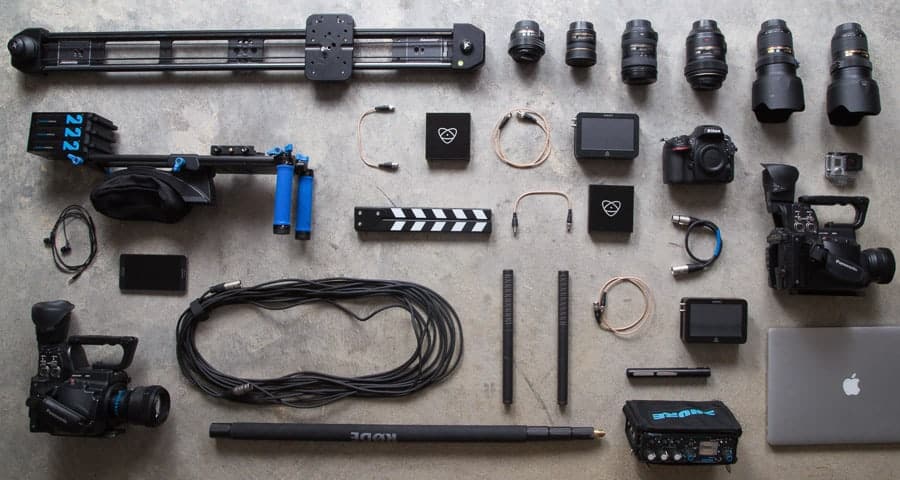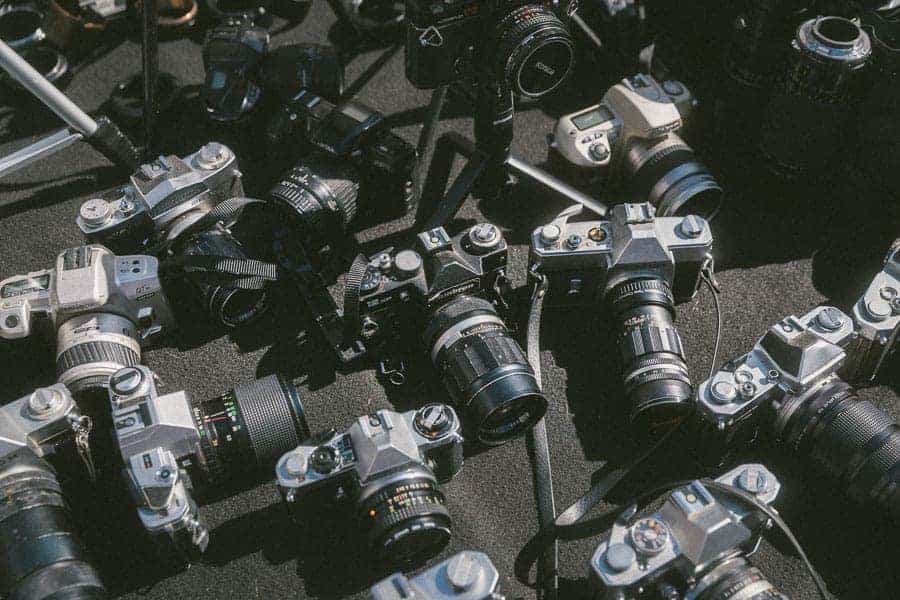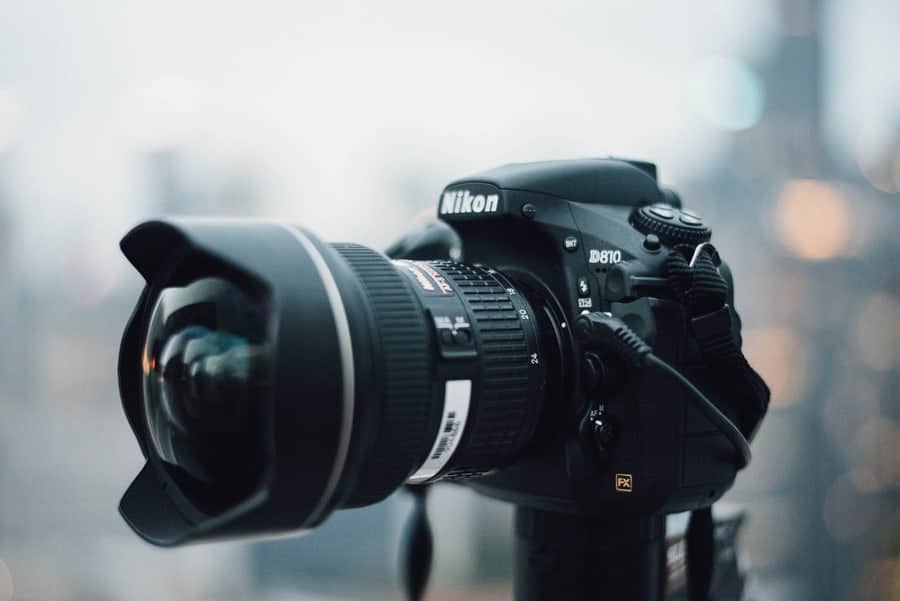
I wondered that exact same thing when I decided to begin my photography business just a few short years ago.
The most important thing is to not let the lack of “professional” equipment hold you back.
I have heard many photographers say that they can start going after paid work as soon as they get that new lens or as soon as they get that full frame body.
All they ended up doing was delaying their chance at success.
Gear does not make you a good photographer and it certainly doesn't make you a good businessperson. But by the same token, anyone who says gear doesn't matter at all is also wrong.
So if you're just getting started in your business and are overwhelmed by all the gear you THINK you need, check out these tips first.
Don't Chase The Gear
If you have intentions of starting a photography business then I am going to go out on a limb here and assume that you have a camera and a lens.
Ok, good.
You have all the gear you need to start a photography business.
Most clients don't care about your lens (sure maybe some high end commercial clients want you to use specific gear but if you are landing those then this article isn't for you).
Over the course of the first year or so of my business, I shot many family portraits and got paid well for it and I was shooting with a used Nikon D5100 and a 50mm 1.8.
That's it.
Now of course if you shoot weddings, you need more high end gear (and you should probably have a body with dual card slots) but there are ways around that too.
Don't Go Into Debt
Probably the biggest mistake photographers make when starting a business (other than not getting insurance) is buying a massive amount of gear on credit because they think they need it.
The problem is that now the new photographer who may have quit their job to work for themselves, now traded their boss for the credit card company. They work for them now. Every month the interest accrues the photographer's income decreases.
They end up taking jobs they many not really want just because they need the cash. They don't spend any money on marketing to bring in new clients because all the profits are going towards paying off the gear.
Of course small charges on a credit card are not going to sink a business, but too many people think they need to buy ALL the gear right up front or they aren't a professional photographer.
That handcuffs them from taking the business in the direction they want and can have long term effects on the viability of the business.
No matter how much gear you have, the beginnings of your business are going to be a little lean in the income department. Starting off with thousands of dollars of debt from purchasing gear is a sure way to kill your business before it even gets started.
Make It Work Then Make It Better
Build your gear incrementally, as you build income.
The alternative to going into debt is buying the gear you need as you can afford it.
This is the path that I have taken. It means that I shot a lot of portrait clients with a crop sensor camera and a nifty fifty. Do you want to guess how many complaints I got about the gear?
Sure there were shots that I wished I could have gotten for those clients. I am a huge fan of the wide angle environmental portrait, especially at sunset. But getting that one shot was not worth incurring debt on my new business. The 50mm 1.8 got the job done. In fact, it got the job done so well that I started to average well over $500 per family portrait session. First I was able to upgrade to a (very underrated) Sigma 18-50 2.8 for my crop body and then by the end of 2017 I purchased my first full frame camera.
But even then, I avoided the $3,000+ new cameras out there and went for a used Nikon D750. The brand doesn't matter but the reason does. I wasn't shooting models or high end commercial clients. They had no idea what the difference was between a D750 and a D850. There was no valid business reason for me to break the bank. Instead I spent the money on marketing, some lighting gear, and insurance.
Smart photographers invest in their business, not just their gear. Sometimes the gear is a good business investment, but most times you are just convincing yourself that you need something when you really just want it.
Stick to the rule of only spending money after you have it in your hands and you'll be building your business on solid financial ground.
Make it work then make it better.
Rent For Specific Needs
So what do you do when you need gear that you don't have?
Rent.
Renting camera gear isn't cheap but it's a whole lot cheaper than buying it, especially if you just need something for one shoot.
Many photographers think that not having gear can limit them in the types of jobs or clients they can take on.
Completely wrong!
If a potential client approaches you for a job and you have the skills but not the gear, graciously accept the job. All you have to do is make sure that you are being paid enough to cover the rental of the gear you need and still make the profit you want to make.
At this point in your photography career, you have to accept that you'll be making less profit for each shoot because you'll be renting gear. You may even feel like you're “throwing money away” by paying for something you'll never own. Get over it! It's much better than paying way too much for something you'll never use.
Don't forget, you can also deduct the rental fee as a business expense.
 Focus On What You Need And Not What You Want
Focus On What You Need And Not What You Want
This one kind of goes along with #1.
This is the positive side of not chasing gear.
We all want that new 1.4 prime lens or that new body with amazing low light performance, but what gear do you really need?
Get ready, this is going to be boring. You definitely need insurance and you probably need things like accounting software and money to spend on advertising. Those are the “gear” purchases that will keep you financially secure and get you more paying clients in the door.
In case you missed it before, most clients don't care about your lens.
Get Gear That Serves Your Client's Needs Before Yours
We already covered focusing on needs and not wants. Now let's narrow that down even more.
You need to figure out what gear serves your client's needs. What that means is take stock of the kind of things your clients are asking for when you book them. Do a lot of your clients want dramatic sunset portraits on the beach? Then maybe your next gear purchase should be some kind of portable lighting solution that works well in less than ideal conditions (a speedlight, a small softbox, and a sturdy tripod rather than a regular light stand perhaps).
You get the idea. Focus on the things that serve your client's needs. Those should be the first purchases before that fancy new lens. You may even find that a lot of the things that fit this description are relatively inexpensive compared to the camera gear you want.
These decisions are the kind that allow you to deliver better images for the client and, in turn, book more clients. Fill up that calendar with shoots and you'll have that new camera and lens in no time.
But before you buy it, check out the last tip.
 Learn About ROI
Learn About ROI
R..O…what?
ROI stands for “return on investment.” It is the basic business fundamental that underlies most of what the rest of this article is about.
Return on investment means analyzing whether an expenditure of money for your business is going to result in additional income.
For example, if you know that you make $500 profit on average for every portrait client, you book one portrait client for every 10 leads you get and 1 lead costs you about $10 in Facebook Ads…then after spending $100 in ads your ROI is $400. That's awesome and it means that if the numbers hold true, you can feel comfortable about spending a lot of ads knowing that your ROI is positive.
You should be applying that mindset to gear purchases as well. Everything we talked about so far is about analyzing what is best for the business rather than what you want.
Do you want that new Nikon 105mm 1.4? It does look really cool. Ask yourself how would you use it? Are your clients clamoring for that look? Can you quantify the profit increase that would result from that $2,000 purchase? Would there be any profit increase? How much would you make if you took some of that $2,000 and invested it in Facebook ads or maybe a marketing course that will help you build your client base?
These are all ROI questions you need to be asking yourself. If you can't identify a quantifiable increase in profits as a result of the purchase then consider that the real reason for purchasing it is that you want a new toy. Nothing wrong with that but then ask yourself if you would buy that new toy if you were a salaried employee and were spending your paycheck on it. Because you are. Don't use the business as a justification to get new toys.


 Focus On What You Need And Not What You Want
Focus On What You Need And Not What You Want Learn About ROI
Learn About ROI
very useful, thank you!
Excellent article. I completely agree. I have just photographed a £5m house using a Canon 6D, Canon 17-40mm lens and a Manfrotto tripod.
Nothing else.
The house owner said “the photos are so good we might stay here”
Rick McEvoy – http://www.rickmcevoyphotography.co.uk/
If you’re going to run a business, it’s a good idea to get a handle on cost accounting. It might sound formidable, but it teaches you same basic & immutable truths about running a business.
I’ve seen lots of people running around telling their friends they’re doing OK, because they can now draw so many dollars a week. Pardon? – what about the interest value of the money they invested to start the business? – the “opportunity cost” represented by the wages they could have got elsewhere? Sorry – but until ALL expenses are covered, INCLUDING those two items, the business is not really “running at a profitable level”. Because you could go to work, come home & sleep nights, without the hassle & worry of running a business, if you still got your interest paid on that money and still got your normal wages.
And on top of that, an allowance for risk – for fluctuations in the income levels generated by the business, because it won’t be the same from one month to another, but you still need cash in the bank account to pay all the bils.
Boring, yes, perhaps. Not as much fun as pointing a camera and taking some photos. But it’s basic to your survival in ANY business, including photography.
Figure it like this. You can’t drive a car without a licence. To get a licence, you have to have driving lessons and prove to the examiner that you know the rules of the road. Then and ONLY then are you allowed to drive a car.
And what I’ve just said is pretty much the same stuff, translated into what you need in the way of preparation, before you’re safe to run a business.
If you mess up, you run a serious risk of breaking up your marriage, losing your home and your family, and ending up in bankruptcy. There are things you can do to protect yourself against that – but you need to learn what they are, before you put the keys in the ignition and start the engine.
spot on!
Thanks!
I feel like this article was written by me; not in terms of the advice (a lot of it was useful, and unfortunately not always what I follow), but in experience. I started with Nikon D5100 and a nifty-50 (have since added a Nikkor 35 mm, and a 24mm Sigma Art lens), and am considering upgrading to a Nikone D750 as my first full frame. That’s an incredibly encouraging thing to see, to be honest, as I sometimes have gear inadequacy.
Jared, go for the D750. You can get them for a great price now. It might drop even more when Nikon officially unveils their new mirrorless model. There is very little that you can’t shoot with that camera. I LOVE it.